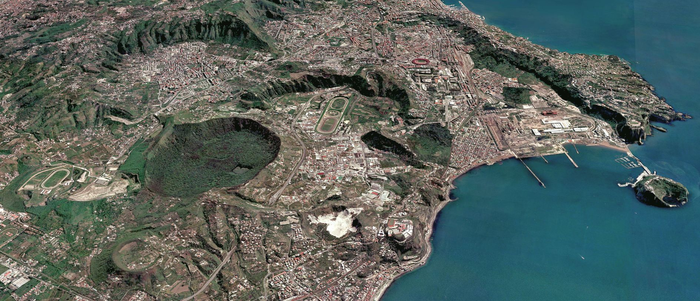Mount Vesuvius is the infamous volcanic force that looms over the Gulf of Naples. However, it’s less known that this idyllic pocket of the Italian coast is also home to another peril: Campi Flegrei.
Given its potential to rain hell on a major Mediterranean city, it’s been speculated that this active volcano could create the “next Pompeii”, alluding to the catastrophic disaster that unfolded in 79 CE. It’s a sensational claim, but recent research has suggested that fears of Campi Flegrei might not be overblown.
Campi Flegrei lies just 9 kilometers (5.5 miles) west of Naples, Italy’s third-largest city that’s synonymous with thin-based pizzas. It doesn’t look much like a typical mountainous volcano as it has formed in the shape of a gentle depression 12 to 14 kilometers (7.5 to 8.7 miles) across, which volcanologists call a caldera (pictured below).
The last time it erupted was almost 500 years ago, although it’s been showing signs of increasing activity over the past century with two-year spikes of unrest in the 1950s, 1970s, and 1980s, and a slower phase of unrest over the last decade.
In a study published in June 2023, scientists at UCL studied the patterns of earthquakes and ground uplift that Campi Flegrei has been experiencing in the past few years.
Their work reached a worrying conclusion: magma and volcanic gas has been churning around about 3 kilometers (2 miles) beneath the surface, leading to a persistent rumbling over hundreds of small earthquakes each.
Not your typical volcano: View of Campi Flegrei near Naples.
Image credit: Giuseppe Vilardo CC BY-NC-ND
The activity is so powerful it has raised the coastal town of Pozzuoli by nearly 4 meters (13 feet) in recent times. If it continues, the researchers fear the volcano could be stretched to breaking point, leading to an eruption.
“Our new study confirms that Campi Flegrei is moving closer to rupture,” Christopher Kilburn, lead study author and Professor of Volcanology and Geophysical Hazards at UCL Earth Sciences, said in a statement.
However, the researchers were quick to point out that nothing is guaranteed and volcanic eruptions are notoriously tricky to predict.
“The rupture may open a crack through the crust, but the magma still needs to be pushing up at the right location for an eruption to occur,” Professor Kilburn explained.
When Mount Vesuvius erupted in the Gulf of Naples in 79 CE, it’s estimated that the population of Pompeii and Herculaneum, the two Roman towns that took much of the brunt, were home to over 20,000 people.
Today, it’s estimated that the Campi Flegrei caldera, Naples, and its surroundings are inhabited by more than 1.5 million people. Around 360,000 people live on the volcano’s “roof”.
While it would be naive to make any predictions about the devastation Campi Flegrei could bring to the Mediterranean, history tells us that the potential for disaster is there.
For now, we can only hope that Campi Flegrei’s murmurings don’t escalate and their temper is gently calmed.
“It’s the same for all volcanoes that have been quiet for generations. Campi Flegrei may settle into a new routine of gently rising and subsiding, as seen at similar volcanoes around the world, or simply return to rest. We can’t yet say for sure what will happen. The important point is to be prepared for all outcomes,” explained Dr Stefano Carlino from the Vesuvius Observatory.
Source Link: The Next Pompeii? Another Volcanic Titan Lurks In The Mediterranean
